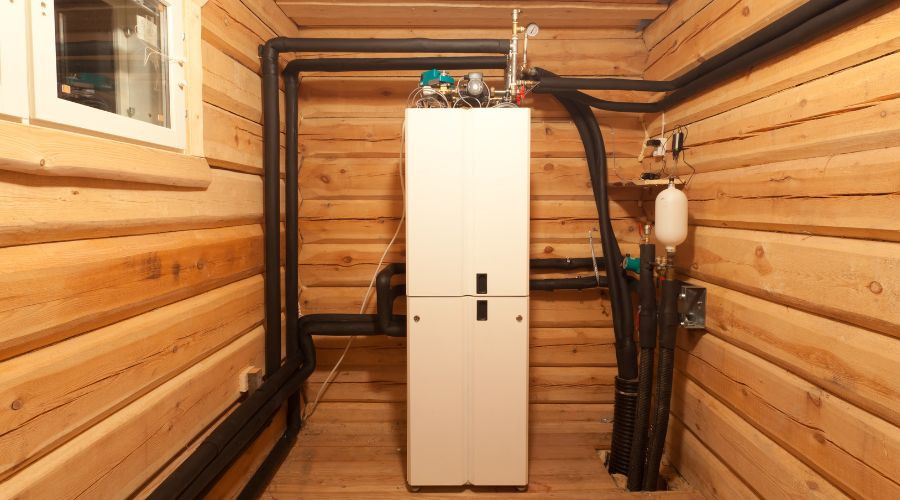Geothermal Heating and Cooling Explained
As energy costs continue to rise and environmental concerns take center stage, homeowners are increasingly seeking sustainable, efficient alternatives to traditional HVAC systems. Geothermal heating and cooling systems, while not a new technology, have emerged as a compelling solution that harnesses the Earth's constant underground temperature to regulate a home's climate year-round.
By tapping into this natural resource, these systems can reduce a homeowner's energy bills while significantly decreasing their carbon footprint. Whether building a new home, replacing an aging HVAC system, or simply exploring ways to make the home more energy-efficient, geothermal heat pump systems could be the way to go.
What Is a Geothermal Heat Pump?
 A geothermal heat pump system harnesses the constant ground temperature to provide efficient heating and cooling for homes or buildings. Unlike traditional furnace systems that generate heat, a geothermal system transfers existing heat from the ground to a home through a series of underground pipes filled with water or refrigerant, known as a ground loop. This system capitalizes on the fact that the ground temperature is warmer than the air above it during the winter. So, during winter months, the heat pump extracts warmth from the ground, concentrates it, and distributes it to the home.
A geothermal heat pump system harnesses the constant ground temperature to provide efficient heating and cooling for homes or buildings. Unlike traditional furnace systems that generate heat, a geothermal system transfers existing heat from the ground to a home through a series of underground pipes filled with water or refrigerant, known as a ground loop. This system capitalizes on the fact that the ground temperature is warmer than the air above it during the winter. So, during winter months, the heat pump extracts warmth from the ground, concentrates it, and distributes it to the home.
In summer, the process reverses, and the system removes heat from indoor air, transferring it back outside to cool the space. This heat exchange process is highly efficient, as it requires only a small amount of electricity to operate the pump and circulating mechanisms. The system's ability to work with, rather than against, natural temperature gradients makes it one of the most energy-efficient heating and cooling solutions available.
Benefits of Geothermal Heat Pumps
 Geothermal heat pump systems offer numerous compelling advantages, making them an increasingly popular choice for residential and commercial applications. These systems can reduce energy usage for heating and cooling by up to 50 to 70% due to being highly energy-efficient. This efficiency in operation translates to significant cost savings on monthly energy bills while decreasing carbon footprint.
Geothermal heat pump systems offer numerous compelling advantages, making them an increasingly popular choice for residential and commercial applications. These systems can reduce energy usage for heating and cooling by up to 50 to 70% due to being highly energy-efficient. This efficiency in operation translates to significant cost savings on monthly energy bills while decreasing carbon footprint.
Beyond their superior energy efficiency, geothermal systems outperform even energy-efficient air-source heat pumps in several key areas. They operate quieter, are more efficient, and last longer than an air source heat pump. These benefits and savings make installing a geothermal heat pump a reliable long-term investment for a property.
Signs a Geothermal Heat Pump Needs Service
Like any heating and cooling system, geothermal heat pumps exhibit specific warning signs when repair or replacement is needed. A sudden, unexplained increase in electricity bills, inconsistent heating or cooling performance, unusual noises such as grinding, squealing, rattling, and more, or a burning odor could all signal issues that require immediate attention.
The presence of wet spots or visible leaks around the indoor unit or ground loops also indicates professional attention is needed. Ground loops should maintain consistent pressure, and any pressure loss could mean a leak in the underground piping system. Additionally, if the system is cycling on and off more frequently than usual or running constantly, this could indicate problems. If any signs of problems are noticed, professionals should be called immediately to inspect and fix them. Early intervention can prevent more costly repairs and extend the system's lifespan.
About SOS Heating & Cooling
SOS Heating & Cooling is a third-generation, family-owned business serving the Omaha area. They offer straightforward pricing with no upselling and financing options. Call them for geothermal heating and cooling system installation and services in Omaha, NE.



